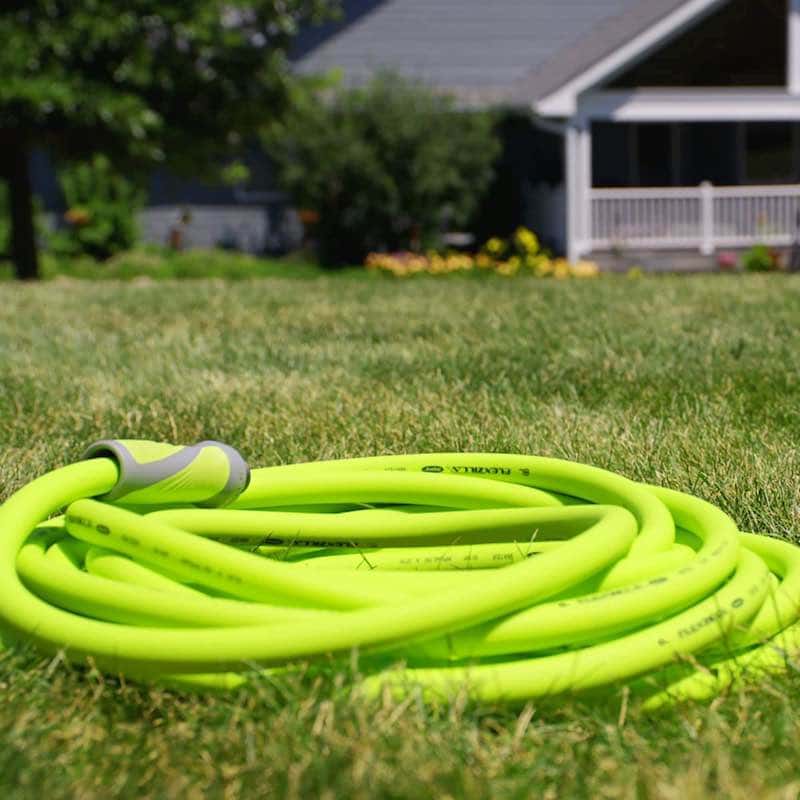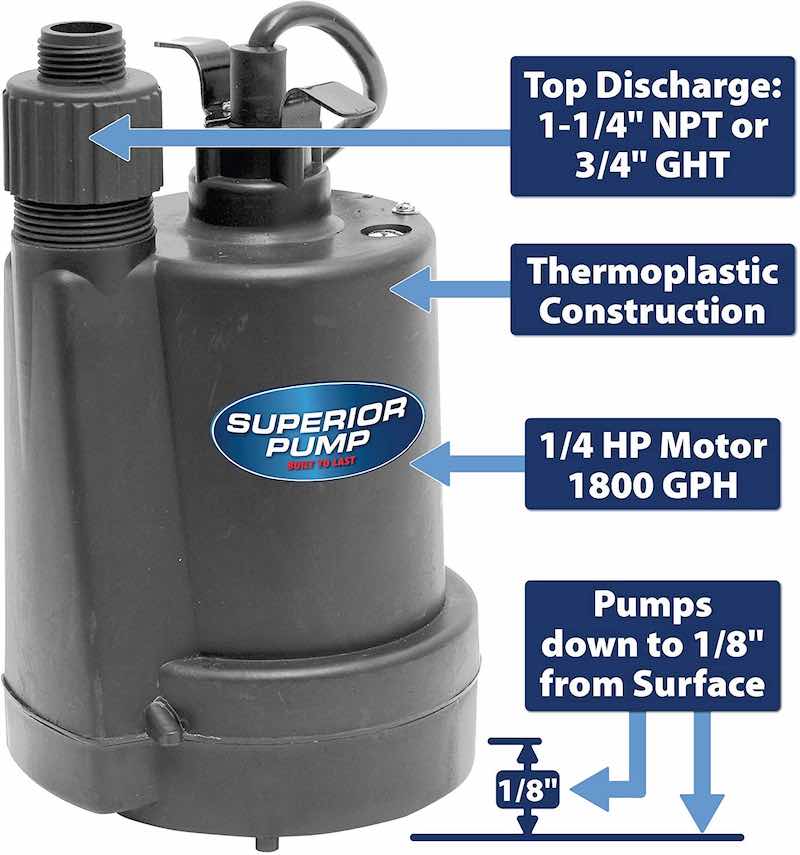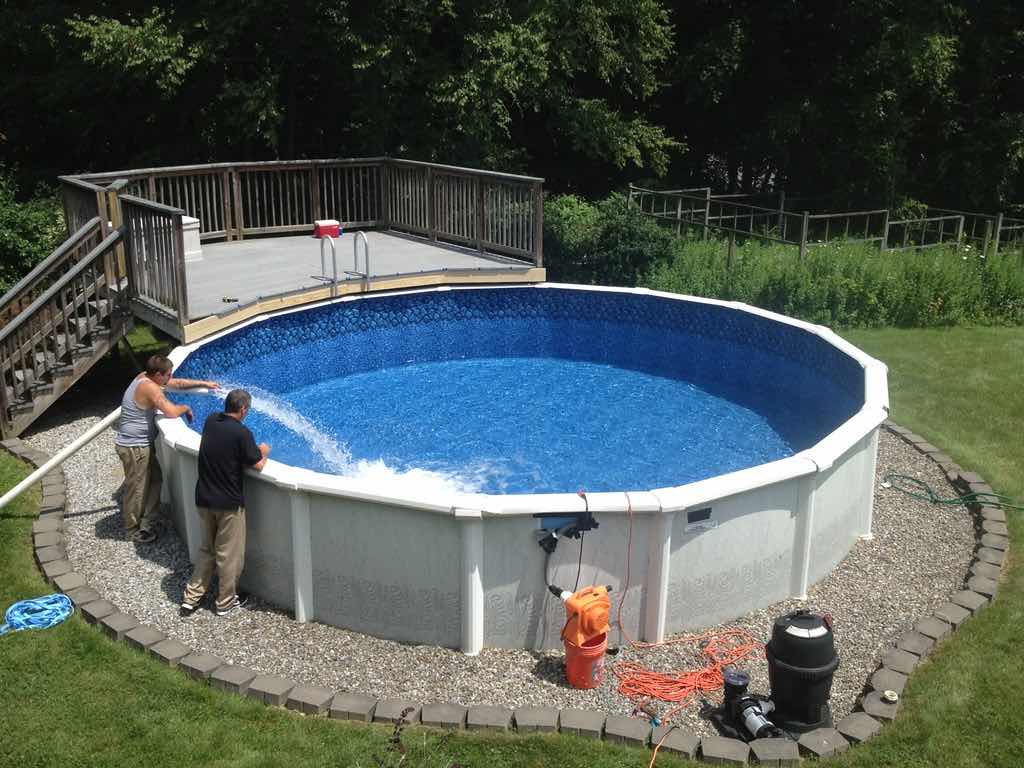If you’ve got an above-ground swimming pool, you won’t need to drain it unless you have big problems, like damage.
But if you’re packing it up for the winter or need to completely rehaul the pool liner, you’ll need that pool drained.
With a hose or sump pump, you can drain your above-ground pool within a single day! We’ll explain more down below, so keep reading!
Completely Drain an Above Ground Swimming Pool: Preparations
You can’t drain your above-ground pool right away! Get these few things prepped first before you start draining.
Check for Any Local Rules
Get in touch with your local water authority and ask them if there are any special rules to keep in mind.
You’ll need to know the safe amount of chemicals in your pool water before pulling the drain plug and whether there’s a proper time to drain.
This will change depending on your area, so remember to check before you start draining!
Turn Off Your Pool Pump
If your pool has a complete pump system, then you’ll want to turn that off completely before you can start draining it.
Anything like your automatic timers and heaters. If you forget to disconnect the parts of your pool pump from their power source, your pump system will end up moving air instead of water.
Don’t settle for turning off your pool’s bells and whistles. It’s easier to shut down the power source.
Find a Location for the Remaining Water
It’s bad to drain your pool without finding a good spot for the rest of the pool water.
Letting the water from an entire pool flow into your yard will soften it up, which might damage your lawn. And don’t think about tossing it into the storm drains either.
Instead, look for your home’s sewer cleanout port. If you can drain your pool’s water straight into the sewer, that will save you a lot of trouble.
Schedule Your Draining
Before you can drain an above-ground pool, you’ll need to fix the water’s chlorine levels first.
This is a vital step because your pool water will eventually end up in your sewers, so you’ll want to ensure whatever you drain is clean.
Stop adding chlorine about 2 weeks before you plan to drain the pool. If you’ve recently shocked the pool, add 3 weeks from the pool shock date.
How to Drain an Above Ground Pool
Now that you’ve prepared your equipment and checked the local rules for water disposal, it’s time to drain that swimming pool!
Drain It With a Garden Hose

With a small enough pool, you won’t need to use a sump pump to drain it. All you need for this method is a trusty garden hose!
Remember that a wider hose can move more water, speeding up the process! You’ll be creating a garden hose siphon to drain your pool.
First, place your hose completely inside the pool, ensuring that you keep the whole thing under the surface. Keep both ends of the hose inside the pool to fill it with water.
With one end remaining in the pool, take the other end out of the pool. The other end should be lower than the pool floor to make a proper siphon.
Let the siphon keep flowing if both ends of your garden hose are secure. Keep an eye on your pool to ensure the water level goes down.
This will drain your pool, but the water flow will take longer than a pump. Once the water level is roughly 1 foot deep or less, take your garden hose out.
What if The siphon isn’t working?
If your pool is too low to drain water with a siphon, you can use an outdoor tap instead. You’ll still be making a siphon, but a little differently.
Submerge one end of your hose within the pool, then attach the other end to your tap. If you have some help, ask them to weigh down the poolside end.
Turn on the tap until your garden hose is filled up. Once it’s full, unscrew it from the tap and let the water flow out.
Use a Sump Pump to Drain Your Above-Ground Swimming Pool

Maybe your pool is too large for a common garden hose to handle. In this case, you can drain your above-ground pool using a submersible electric pump instead.
Before setting up your sump pump, remember to choose a spot for the pump’s outlet hose! As with the garden hose method earlier, you’ll need to drop your pump’s intake hose within your pool.
Try to center it as much as possible for faster draining. You’ll need to stay by your electric pump until all the water (or most of it) has completely drained.
As long as the water level is consistently going down, you should be fine. Keep checking your sump pump occasionally to ensure it’s working properly.
This can take anywhere from 8 to 14 hours, so ensure you have enough time to drain the pool. Once your sump pump is no longer pushing water out of the pool, you should turn it off.
You’ll be left with a small puddle of water. If you need to completely drain the pool, move to the “Final Cleanup” section below.
What if My Pool Is Too Far From an Outlet?
You can drain water from your pool faster with this method, but you’ll also need a power cord.
However, if the distance between your nearest outlet and your above-ground pool is too far, it’s time to bring out an extension cord.
Ensure your extension cord is tough enough to handle the power running through your submersible pump.
Final Cleanup
Whether you set up a garden hose siphon or a sump pump, neither method will completely drain your swimming pool.
After enough time, you’ll be left with a few inches of excess water sitting in the middle of your pool.
A low water level won’t cause any issues if you’re doing minor repairs or adjusting the chlorine levels in your pool.
However, if you need an empty pool, you can get rid of your water in a few ways. If you used an electric pump to drain the water, turn it off first.
Flip It Over
Remove your pool’s liner from the frame, and flip it to drain the water into your yard. Find a spot far away from your pool’s normal area so the ground won’t soften.
If you can access your sewer cleanout port, use it! This will drain the water directly into a nearby sewer line for easier cleanup.
Scoop or Drain
If you have a shop vac on hand, use it to finish the job. If your pool has a drain, move the remaining water towards it.
What if I Need to Refill the Pool Later?
If you’re not putting away your above-ground pool for the winter, you’ll want to refill it soon after you drain it. An empty pool is at risk of damage from the sun!
Most pool maintenance jobs won’t require you to completely drain out your pool. But if your pool’s got a chemical imbalance or the liner has major damage, you’ll need to drain it.
Recommended reading:
After you’ve finished fixing up the pool, you’ll need to grab your hose again. Just like draining, the refilling process will go faster if you can borrow an extra hose or two.
Refilling your pool will take roughly the same amount of time as draining it in the first place. Remember to block off your schedule!
Frequently Asked Questions on How to Empty Above-Ground Pool: By Hose or Pump
Make pool maintenance easier!
Why Would I Drain an Above Ground Pool?
There are a few factors that will have you draining your pool.
Special Maintenance
Let’s say you forgot to drain your pool last winter, and now your pool’s liner is heavily damaged. To replace it properly, you’ll need that pool completely drained.
You Need to Put It Away
If winter is approaching, you’ll have to store your above-ground swimming pool. Draining it will make it much easier to pack things up.
Plus, draining it before winter will ensure you don’t end up with a damaged pool next year!
The Pool Water Is Chemically Imbalanced
Everything you place inside your pool water will affect its chemical balance. This doesn’t just mean your chlorine and chlorine stabilizer.
Using the pool will increase the amount of total dissolved solids (or TDS). Your sweat, shampoo, and deodorant will affect your pool’s TDS.
Once your pool gives a TDS reading higher than 2000 PPM, it’s time to break out the pump.
How Do I Keep My Above Ground Pool Safe After Draining It?
You may have a few issues afterward if you completely drain your above-ground pool. Here’s how to avoid them!
Avoid the Heat
No matter how heavy-duty your pool liner is, it won’t do well if you leave it in the blazing heat.
That’s because all the water that cools you down in the summer also shields your pool liner from heat damage. An empty above-ground pool is prone to warping and cracking.
To keep your pool liner safe, wait for a little cloud cover before draining it. You can drain your pool safely when the weather hits around 85 degrees F.
Maintain Your Pool’s Structure
The water your pool holds is one of the most important things helping to keep its structure. Draining your above-ground pool removes that added structure.
Make sure that you drain your swimming pool on a calm day. Stiff winds and hail can cause your pool liner to crumple and develop nasty cracks.
Keep Mold and Mildew Away
Once you’ve finished draining the pool, you’ll need to dry it out completely. You don’t want to pack up your pool when it’s still slick with the remaining water.
Packing up wet pool liner is a guaranteed recipe for mold. Give your pool liner time to air dry, but make sure it’s got some shade.
If you have a shop vac, you can use it to speed up the process. Once it’s dry enough, finish the job with plenty of towels.
Recommended reading:
How Do I Pack Away My Above Ground Pool Safely?
Now your pool’s completely dry, but that isn’t the end of this method! If you have an extra pair of hands available, ask them to lay out your liner on a flat, soft area.
Avoid laying out your liner in hard and pointy spots, so avoid sharp rocks. Fold up your pool liner evenly, and store it in a nice dry container.
If you plan to store the pool’s frame, follow your manufacturer’s step-by-step directions. Then shove it somewhere dry indoors.
But if you’re not, just throw a tarp on it and fasten it to the ground. Come next summertime, and your pool will be good to go!
What if My Pool Has Chlorine Lock?
Part of pool maintenance is maintaining a steady chlorine level in the water. Unfortunately, even the most obsessive pool owners can encounter the dreaded “chlorine lock.”
This means you have too much chlorine flowing in your pool, and it’s no longer disinfecting the water properly. Adding more won’t help, so you’ll need to start again with fresh water.
If you’ve run into this problem, fixing it is easy! It’ll involve partially draining your pool. Using a submersible pump or garden hose, drain your pool slowly.
The draining process will depend on the size of your pool and the method you use, so make sure you have enough time to completely drain the pool!
Don’t use a regular pool pump for this process because you’ll risk melting your equipment.
Pool Draining: Conclusion
You don’t have to hire a professional to drain an above-ground pool. However, if you don’t have a submersible pump on hand, there’s nothing wrong with hiring some professional help!
If you don’t have a sump pump, create a siphon with your garden hose and slowly drain the pool.
But if you do have an electric pump, use it to drain your pool, and don’t forget to dump your water in the sewers!

2 comments